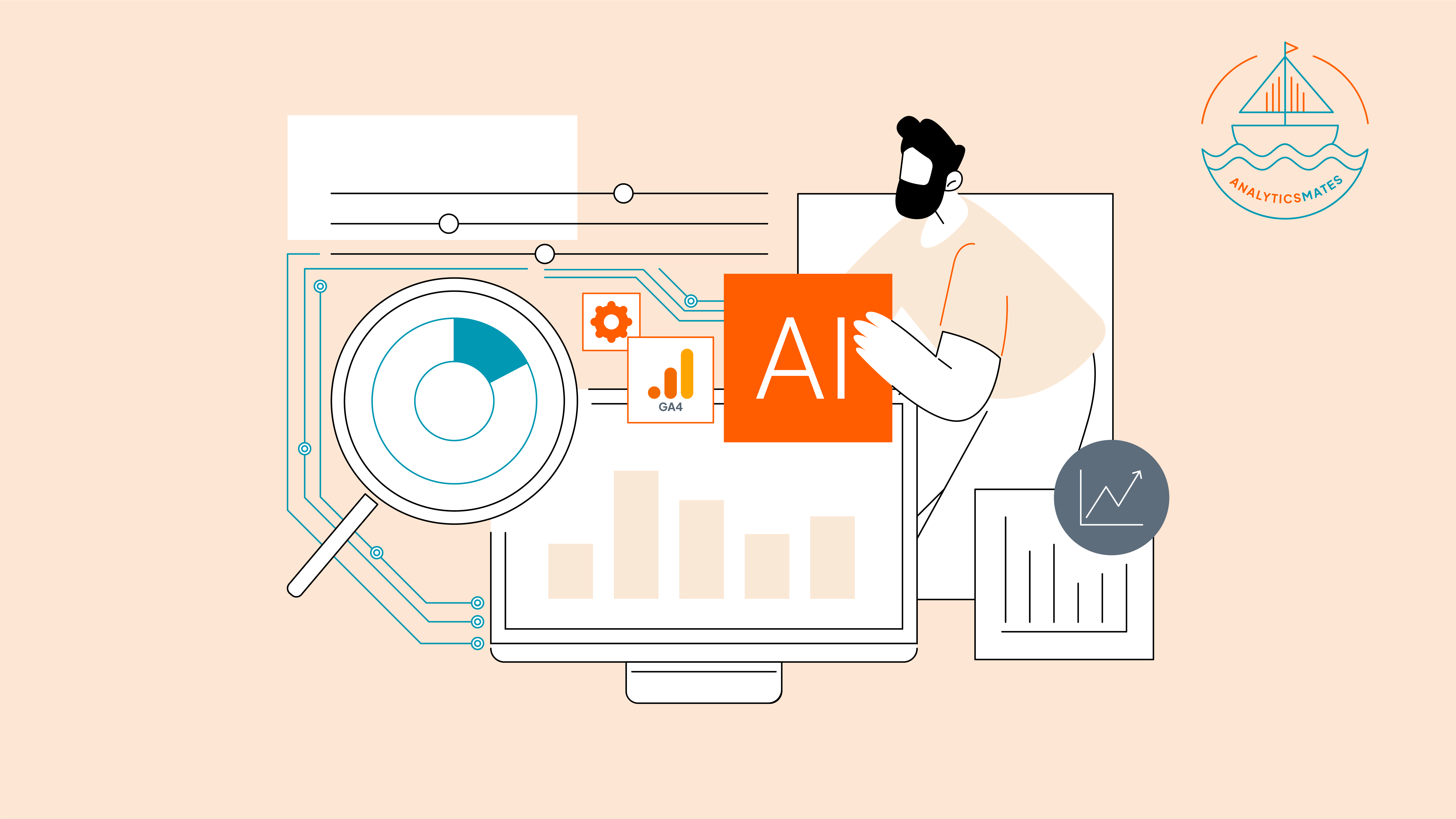You know, things are moving at a crazy pace these days, this is true with digital landscapes too. We, as marketers, feel like we're always trying to keep up, and lately, AI is the big topic on everyone's mind. But past all the trends, many users are still struggling and scratching their heads, wondering how to actually use AI in practical ways that really deliver an effective result or positive impact, especially when it comes to search performance.
In this blog post, we're taking a deep dive into how you can combine the power of AI with Google Analytics 4 (GA4) to get a much clearer picture of your SEO results and really boost them. In this blog, we’ll walk you through how AI can help:
- Surface high-potential keywords you might be overlooking.
- Spot technical issues on your site before they become real problems.
- Optimize existing content with precision based on real user data.
Finding High-Impact Keywords with GA4, GSC, and AI
Effective SEO starts with understanding what your audience is actually searching for. When creating content, we need to ensure our goal is to attract users' interest. And in order to get an idea and insights about this, we need the help of tools such as GA4, Google Search Console, and AI.
Why Keyword Data Matters
Every successful content begins with a keyword that matches the user’s intent. We need to get an understanding on which terms they’re using and how they interact with your site once they arrive. GA4 and GSC give you direct access to this behavior. Later on, AI then takes it a step further, leveraging the tool will help transform your raw data into actionable insights.
Step-by-Step: How to Uncover Top Keywords and SEO Performance
1. Start with GA4: Identify What’s Working
Open your Search Console report and click on Queries report to see the top keywords.
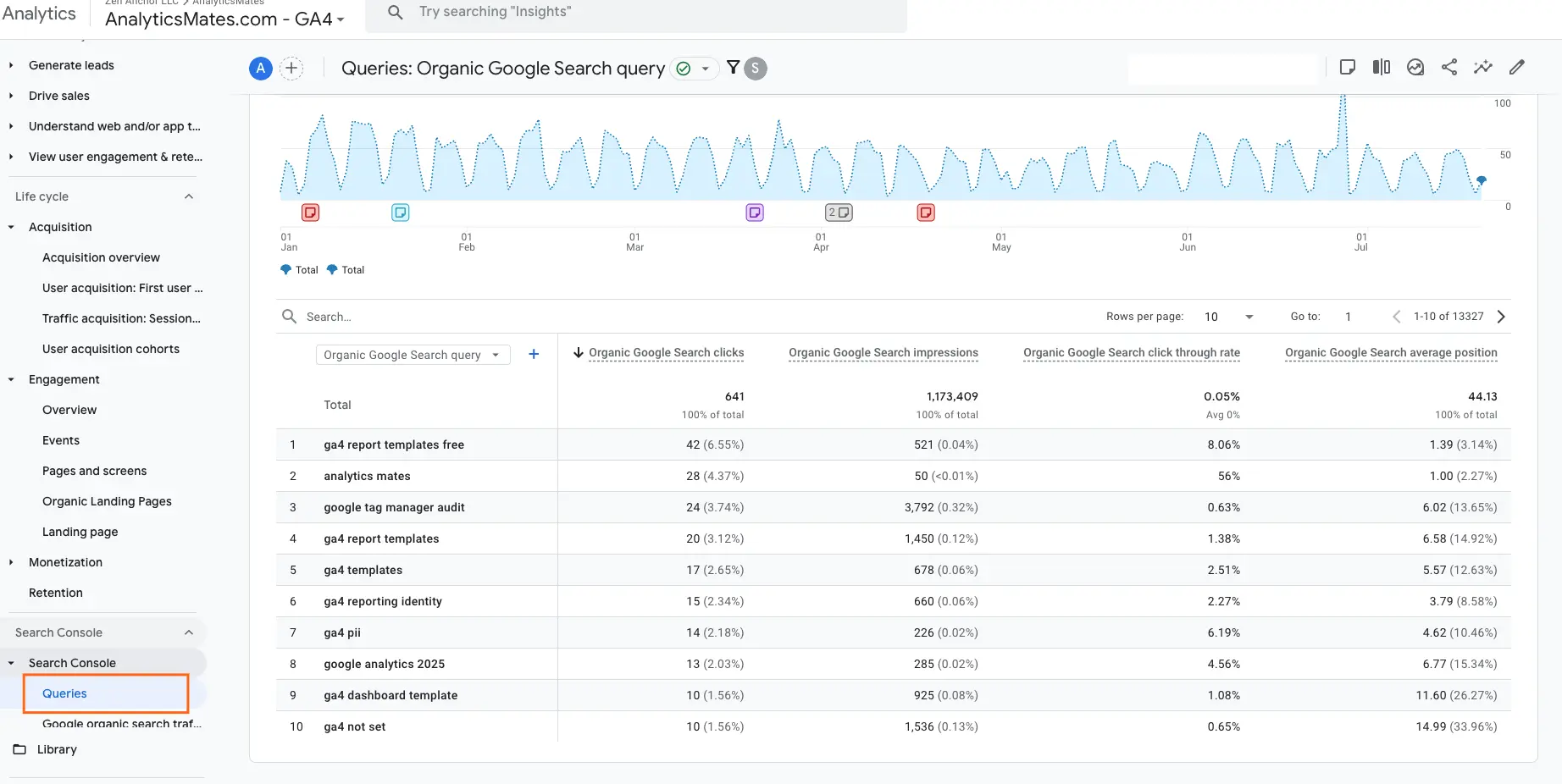
In the same section , you can also check the Google organic search traffic report to see which URLs are attracting the most organic traffic. These are your current high performers.

Key takeaway is you can generate any SEO report in GA4. All you need to do is to filter it to show only the Organic Search channel. For more information, you can check out our previous blog post on how to use GA4 to track SEO performance.
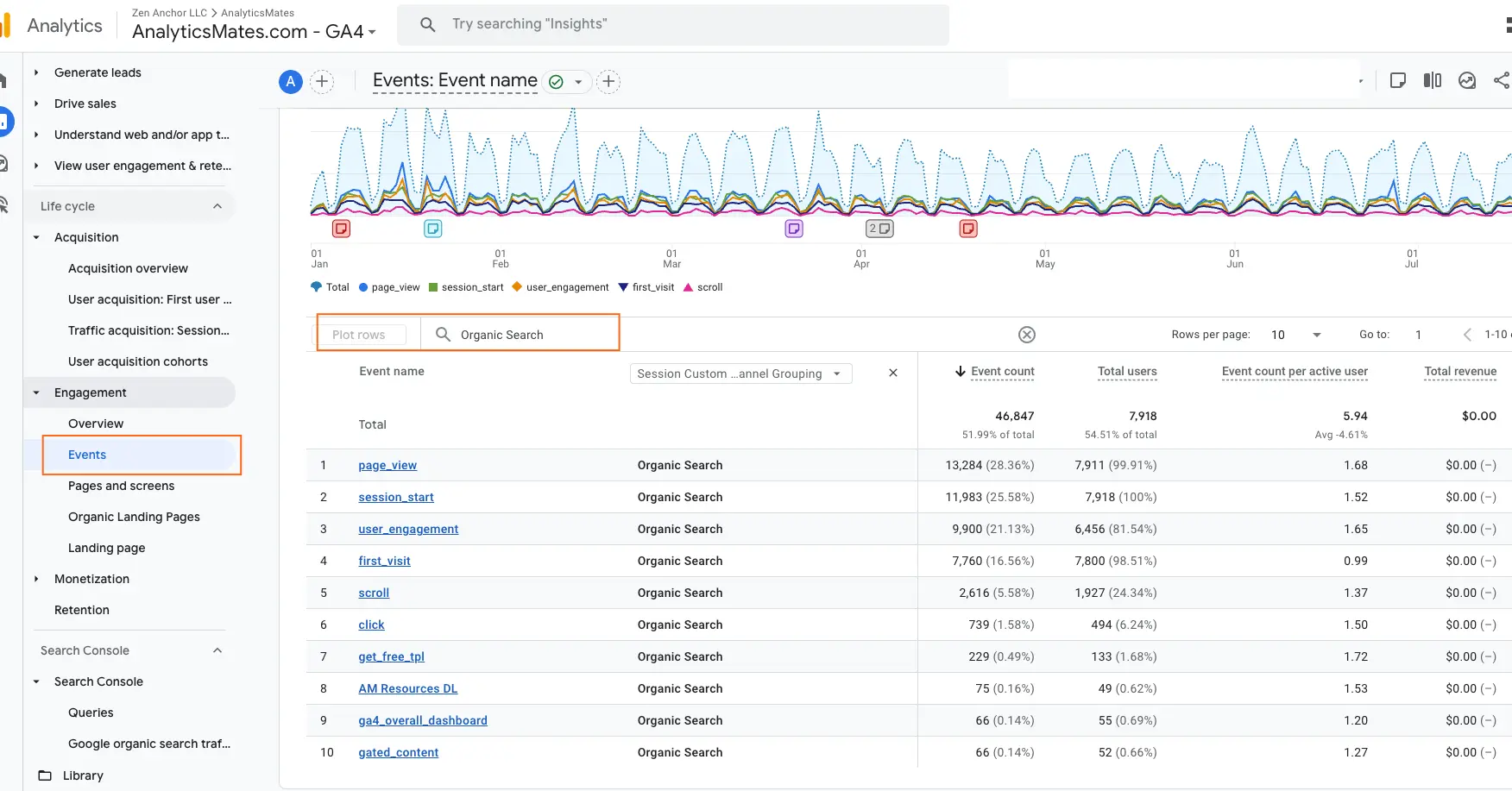
2. Use GSC for Deeper Search Insights
In the Performance tab, view the Queries report to identify which keywords are generating the most impressions and clicks.
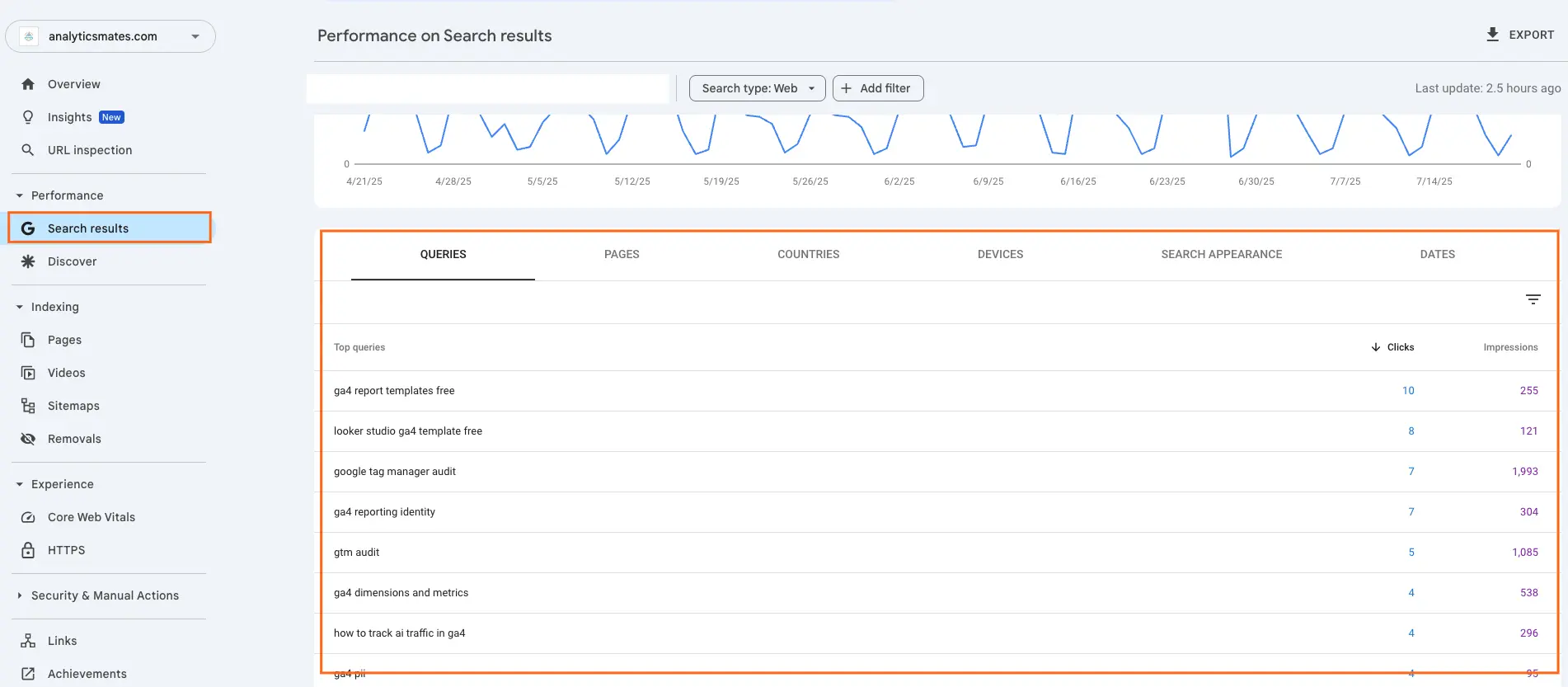
Sort it by Impressions and check for keywords with low Click-Through Rates (CTR). These represent missed opportunities where your content may need a stronger hook or better metadata.
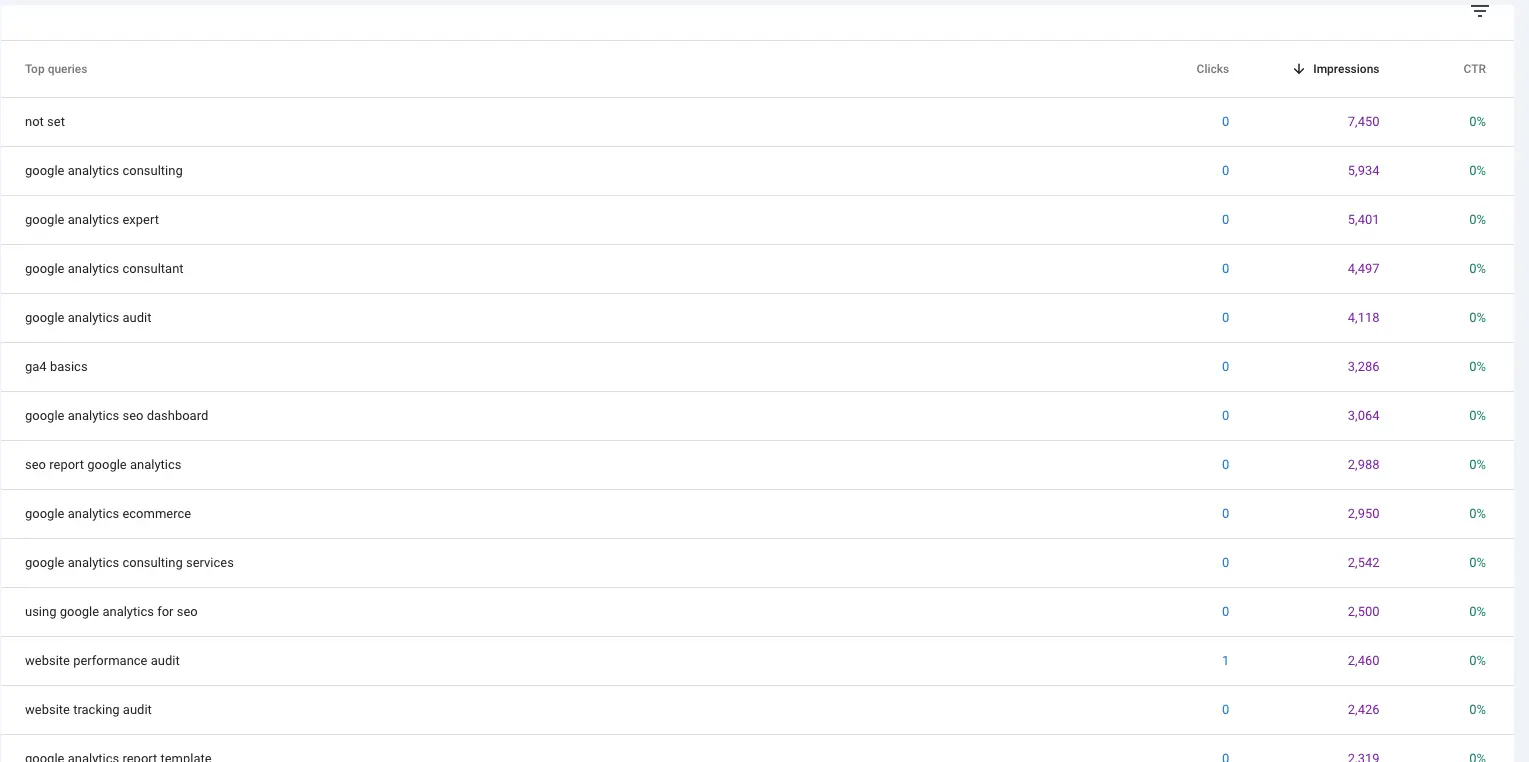
3. Bring in AI to Supercharge Analysis
When you think you have complete data that you need. You can download it from either GA4 or Google Search Console property. You’ll find a quick guide here on how to do that in GA4. Doing this in Google Search Console is easy, you can simply click the "EXPORT" button at the top-right corner of the page.
After downloading the keyword report, import it to your AI tool to put together or cluster keywords by intent (e.g., informational, transactional, navigational).
Sample AI prompt:
Analyze this list of keywords from my Google Search Console report. Group them by user intent (informational, navigational, or transactional) and explain why each keyword falls into its category.
Uncovering Technical SEO Opportunities
Issues like broken links, site pages slow load times, or 404 errors that can impact your rankings and user experience most of the time without even noticing it. Using technical SEO should help you identify these problems.
Spotting Technical Issues with GA4
There are valuable clues in Google Analytics 4 when something isn't working right. Here's how to use GA4 to detect potential technical setbacks:
1. Monitor Bounce Rates and Engagement Time
Head to your Pages and Screens report in GA4. Look for pages with high bounce rates or very low engagement time. This tells you that users are running into errors, delays, or layout issues.
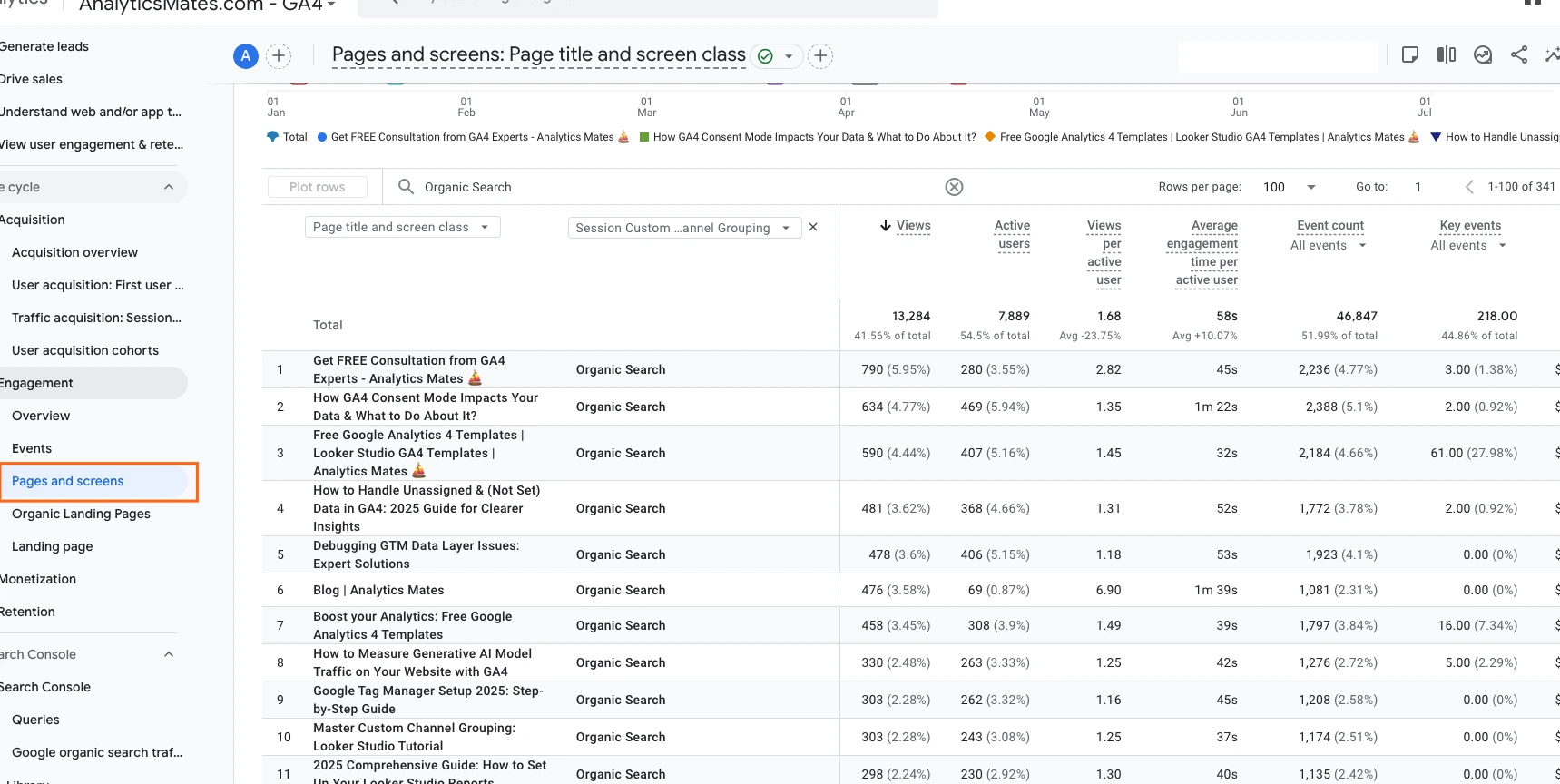
2. Filter by Device Type
Check your traffic by mobile and desktop to check if issues are device-specific. Mobile pages with higher bounce rates than its desktop version could be suffering from mobile responsiveness or speed issues. Something like that…
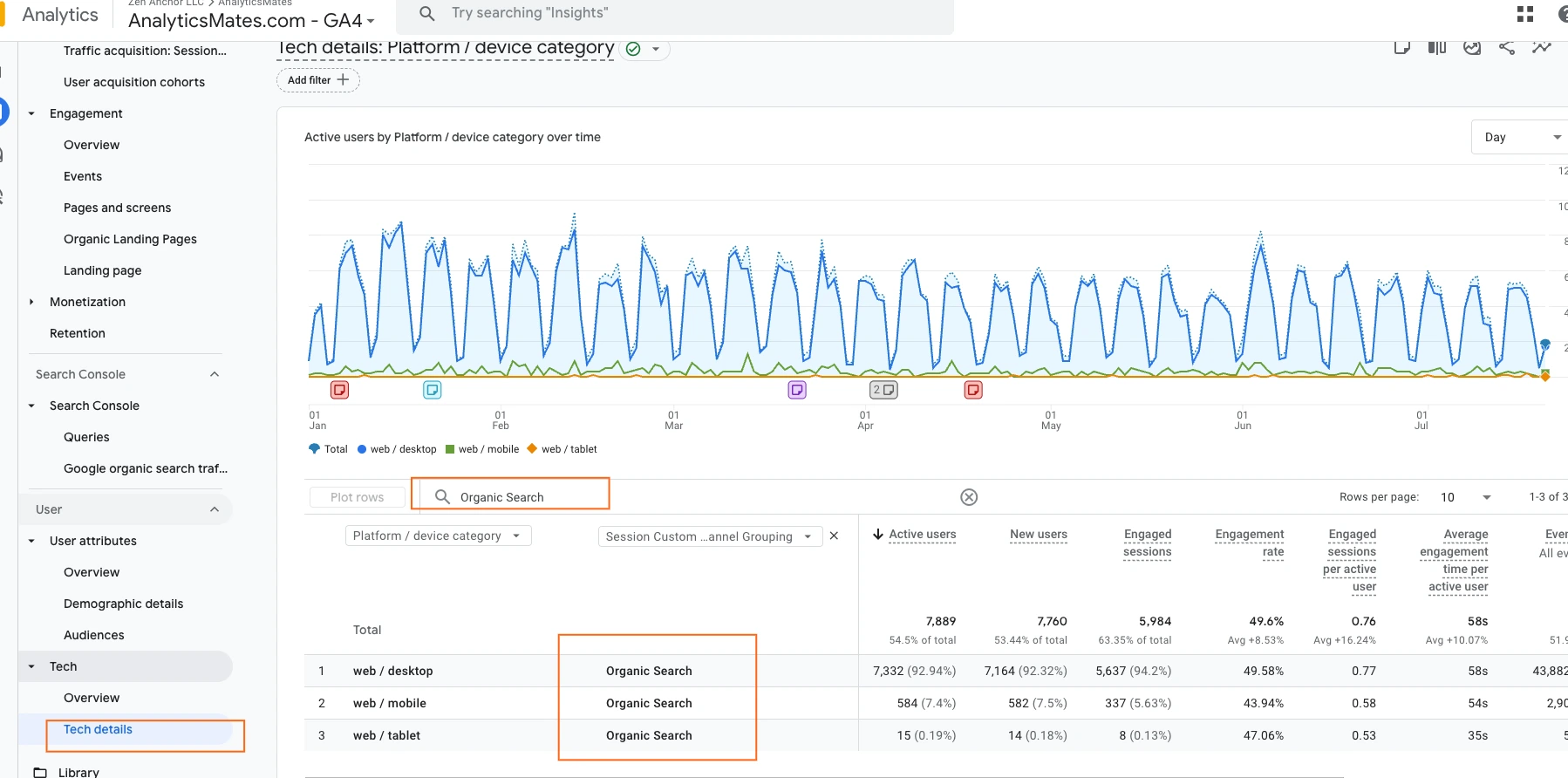
How AI Can Automate and Enhance Technical Audits
Using AI tools can make technical audits more efficient, just like with keyword analysis. The first step here is to export reports from Google Analytics 4 or Google Search Console, then import that raw data into your chosen AI tool. Then by applying or running your AI prompts, you can transform these technical data into actionable insights that will guide in your next SEO strategies or plans.
Sample AI prompt (GA4):
Analyze this report from Google Analytics 4, which includes page-level metrics such as bounce rate, engagement time, and device type. Identify any URLs that may have technical issues, such as slow load times, mobile responsiveness problems, or broken elements. Provide a summary of potential issues for each flagged page and recommend specific technical improvements to address them.
Boost Visibility with Smarter Content Optimization
Improving your content is one of the highest-impact SEO steps you can take. That’s what we’re going to talk about in this next section. Start with Google Analytics 4 (GA4), which gives you the data to identify what’s working and what’s not. Also with the help of AI, you can act on that insight effectively.
Start with GA4: Identify What Needs Work
The first step in content optimization is performance analysis. Within GA4, navigate to your organic traffic reports and look at metrics such as engagement rate, average time on page, and conversions per page.
- Top-performing pages will show strong traffic and engagement. These are your content benchmarks.
- Underperforming pages may have high bounce rates, short view durations, or low visibility in search.
Once you’ve identified which pages need improvement, you can bring in AI to help refine them.
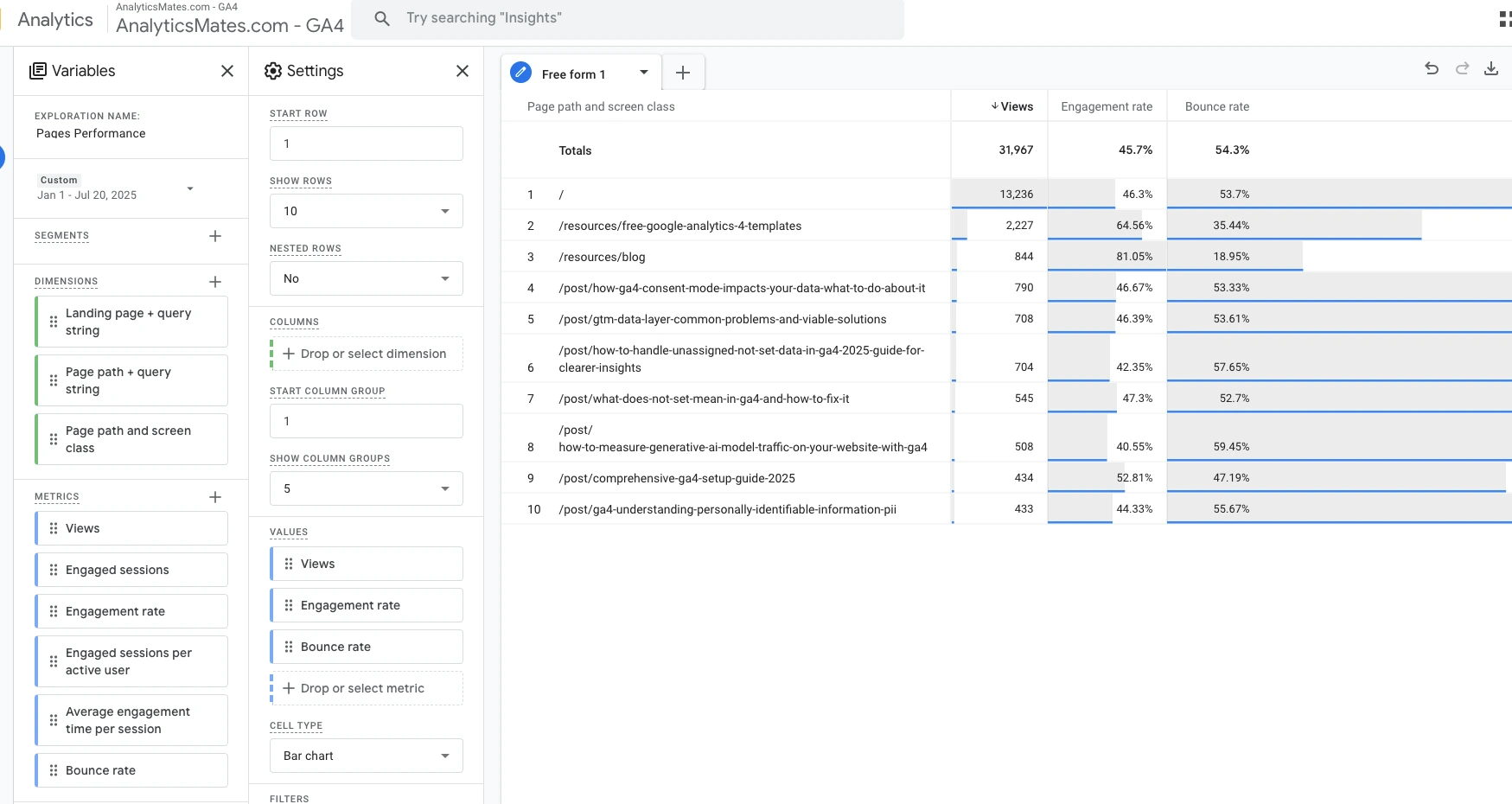
Reminder: Our goal in this post isn’t about using AI to directly optimize your site. Instead, we’d like to show you how to analyze reports from GA4 and GSC, then use AI to turn those insights into a clear, actionable plan for content optimization. Below are some sample AI prompts you can use.
Identify Top and Underperforming Pages
Based on the following GA4 data (page title, views, engagement rate, average session duration, conversions), which pages are performing well and which ones need improvement? Suggest reasons why.
Engagement & Conversion Insights
Analyze this GA4 report and summarize which pages have the best engagement and why. How can I replicate that success across other content?
Turn Referrals into Ranking Power with Smart Backlink Strategies
Referrals usually are websites linked to your content, this is to tell Google that your site is trustworthy and relevant. However, building those backlinks can be a challenge unless you know where to look and how to act on the right opportunities.
In GA4 to look for referral traffic data, you can spot which websites are already linking to you, review and identify potential partnerships that could possibly lead to even more backlinks.
Step 1: Locate Referral Data in GA4
Start by navigating to Reports > Traffic acquisition. In the “Session source/medium” report, filter by “referral” to see a list of websites sending you traffic.
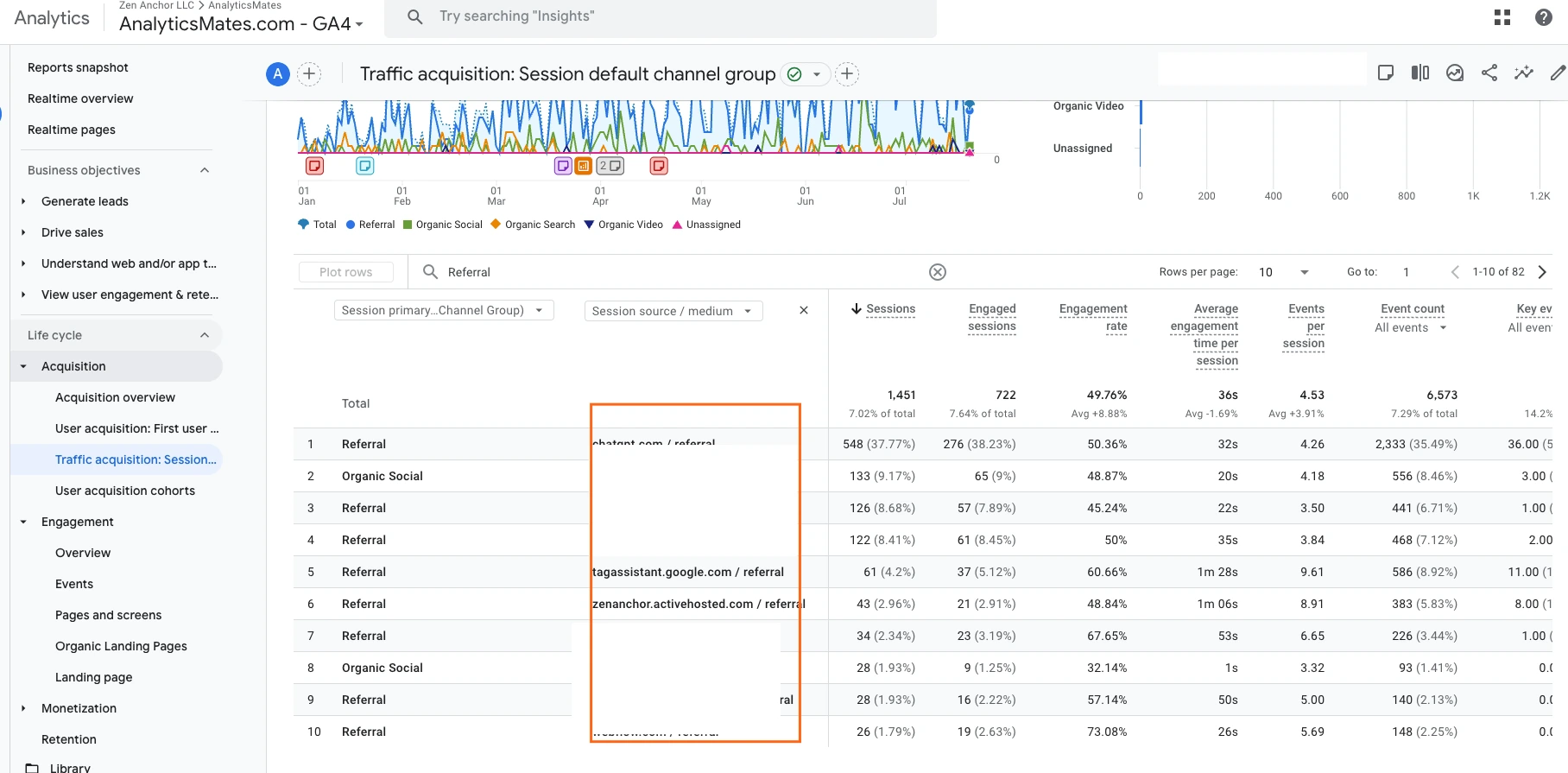
Look for domains that:
- Appear frequently in your referral list
- Come from authoritative or industry-relevant sites
- Drive traffic that has good engagement metrics (low bounce rate, high time-on-page)
These are your backlink goldmines.
Step 2: Analyze and Act on Opportunities
When you’re done identifying referring domains, check how they’ve linked to you, whether through a blog post, guest contribution, or maybe through a quoted mention. Look for similar content formats where partnership with them could work, and consider offering your content as a valuable addition to their resource pages.
Step 3 (Optional): Use AI to Draft Outreach Templates
You can also ask an AI writing assistant to help draft personalized emails. Here are a few example prompts:
"Write a friendly and professional email to a website owner thanking them for linking to my site and offering a guest post on [topic].
Ready to Take Action? Here’s Your Next Step
To help you move forward faster, we’ve created a free resource. A list of AI SEO prompts that you can use to plug into your preferred AI platform.
FAQs
How do I connect GA4 and Google Search Console for better SEO insights?
A: To connect GA4 and Google Search Console, go to your GA4 property, click on “Admin,” then under the “Property” column, choose “Search Console Links.” Click “Link” and follow the steps to select the correct GSC property. Once connected, you’ll gain access to valuable search query data and landing page insights inside GA4 reports.
What kind of AI tools can help with GA4 data analysis?
A: You can use AI writing assistants (like ChatGPT) for interpreting GA4 metrics, summarizing trends, and identifying optimization opportunities. Other tools like Looker Studio with AI integrations or analytics-specific platforms like PaveAI can turn GA4 data into actionable recommendations automatically.
Can AI really help with keyword research?
A: Yes, AI can enhance keyword research by quickly analyzing large datasets from tools like Google Search Console or Ahrefs. You can prompt AI to surface long-tail variations, cluster keyword themes, and even suggest gaps based on existing content performance, all in seconds.
How accurate is GA4 when tracking organic SEO performance?
A: GA4 is accurate in tracking organic traffic, but it focuses more on user engagement than just visits. For SEO, it’s best used alongside Search Console, which gives deeper visibility into impressions and rankings. Together, they provide a more complete picture of SEO success.
What's the difference between GSC and GA4 when analyzing SEO?
A: Google Search Console shows how users find your site on Google Search (queries, rankings, impressions), while GA4 shows what users do once they arrive (engagement, conversions, bounce rates). GSC helps you optimize for visibility; GA4 helps you measure results.
How can AI prompts be used to improve SEO content?
A: AI prompts guide the model to perform tasks like summarizing top-performing content, drafting meta descriptions, suggesting internal links, or finding outdated pages. With the right prompts, marketers can streamline content audits and improve SEO faster than with manual methods alone.
How do I identify and fix SEO-related technical issues using GA4?
A: In GA4, review metrics like high bounce rates, low engagement, or pages with 0 conversions. Pair this with GSC’s coverage report (for indexing errors) or tools like PageSpeed Insights to flag slow load times. AI tools can assist by prioritizing which issues matter most to SEO.
What are some examples of SEO-related GA4 reports I can build in Looker Studio?
- op Landing Pages by Organic Traffic
- Sessions by Search Query
- Engagement by Page Title
- Conversions from Organic Sources
- Bounce Rate Trends for SEO Pages These help visualize SEO progress and identify where improvements are needed.
Is it possible to track backlinks or referral sources in GA4?
A: Yes, GA4 can track referral traffic sources. Go to “Traffic acquisition” and filter by “Session source / medium.” This will show which websites are sending traffic to yours. While GA4 doesn’t directly track backlinks, it can show you which links drive real user sessions.
Why is there such a focus on long-tail keywords in GA4 SEO reports?
A: Long-tail keywords often signal more specific user intent, which usually leads to higher conversion rates. GA4 lets you analyze how niche queries drive engagement, helping you double down on high-performing content and reach users further along in the buyer journey.
Conclusion
It’s not about always going after the latest AI trend or waiting for the next GA4 update. It’s about using the tools you already have right in front of you and making the most out of it. As we’ve discussed in this blog post, it should be clear now that combining GA4 with AI isn’t some future concept, or a distant dream, it’s already happening, and it’s more accessible than ever.
The important thing is to stay curious, experiment, and see AI as a valuable partner (not a replacement). If you’re ready to take that next step, download our AI Prompt Cheat Sheet. It’s a smart starting point to make your SEO process faster, more focused, and more impactful. The future of search belongs to marketers who know how to work with data, and that includes you.
Thank you for reading!
We're always looking for ways to improve our Google Analytics 4 blog content. Please share your feedback so we can make it even better.
See Article Images




